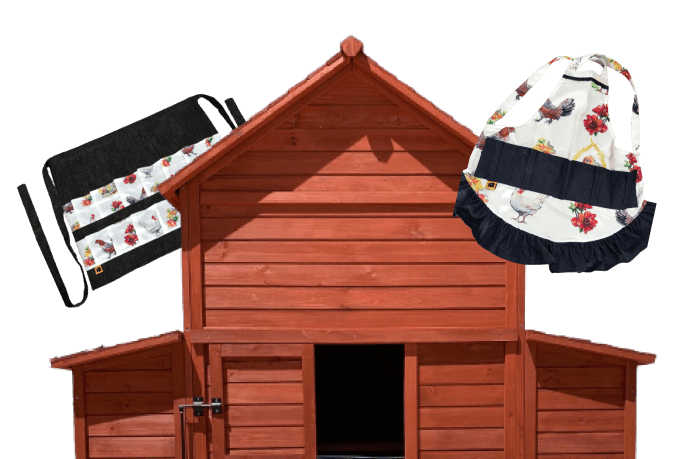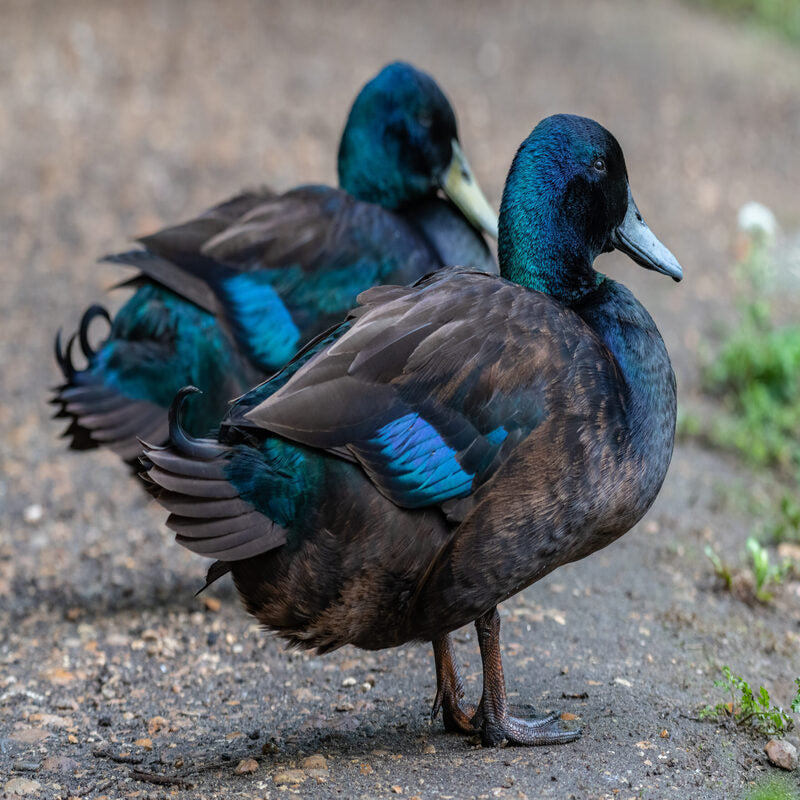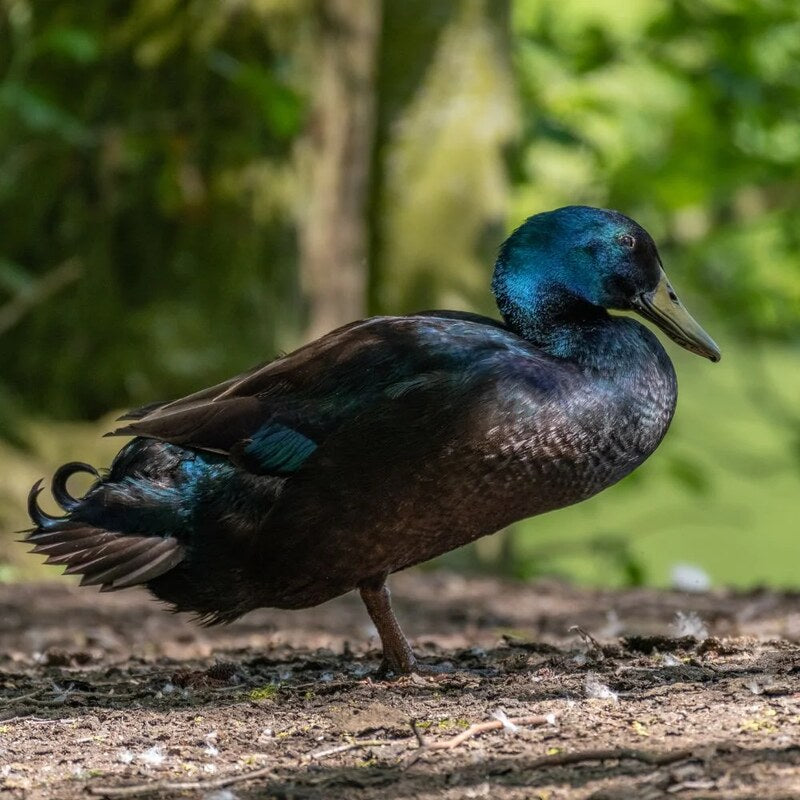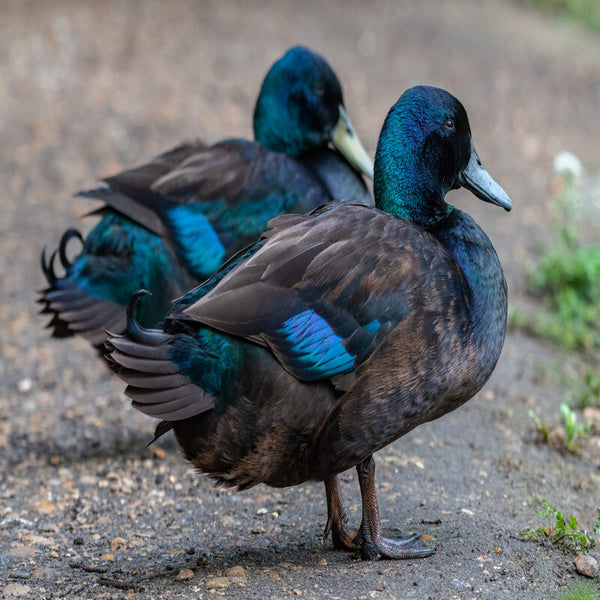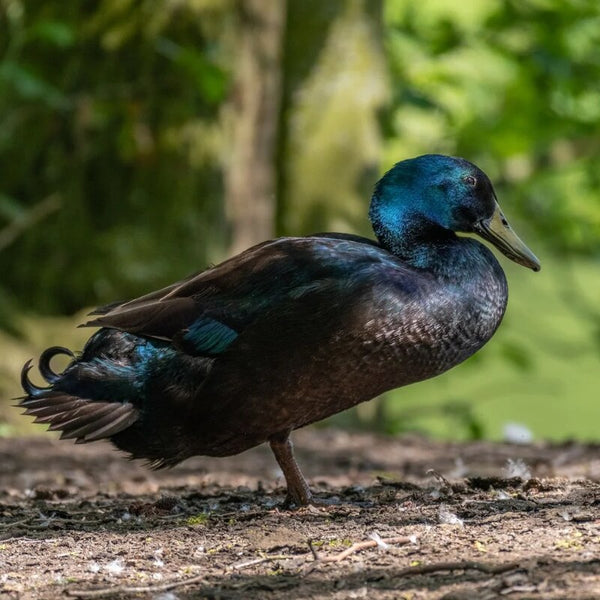Cayuga Ducks
*There is minimum order quantity of 3 Female or Not Sexed chicks and 1 Male chick per breed.
Cayuga Ducks
The Cayuga Duck is an excellent dual-purpose breed used for both meat and egg production and is a favorite in poultry shows. Originally popular near Cayuga Lake in New York State, the Cayuga was recognized by the American Standard of Perfection in 1874.
This breed is known for its stunning, iridescent beetle-green color, which appears on its black feathers under the right light. As Cayugas age, they develop white feathers through natural molting, especially in hens. A calm and active forager, the Cayuga enjoys eating snails, slugs, and other insects, making it a useful addition to any yard. Non-flying, they lay both white and darker eggs, the latter with a dark film rather than a true dark shell.
Appearance:
-
Feather Color: Black with iridescence. The feathers can be black to blue or green depending on the light. Males are slightly darker, females slightly lighter and duller.
-
Body Type: Medium to large. Sturdy, broad body with deep chest and strong frame. Good for meat and eggs. Not as heavy as commercial meat ducks like Pekin but good for small scale production.
-
Head and Beak: Small round head, upright neck. Dark green or black beak. Head is proportionate to body.
-
Legs and Feet: Orange legs. Strong and sturdy. Webbed feet for swimming and good mobility on land and water.
-
Size: Males 7-8 pounds, females 6-7 pounds. Slightly smaller than some meat breeds like Pekin but still good yield of high quality meat.
Temperament:
-
Calm and Docile: Cayuga Ducks are gentle and docile. Great for families, small farms or homesteads. Friendly and can be handled easily especially when raised from young. Not aggressive and good for mixed flock with other ducks or poultry.
-
Active and Curious: They are also curious and active. Love to explore, forage and do natural behaviors. Not as hyper as some other breeds but enjoy roaming free and interacting with other ducks.
-
Good for Free-Range: Cayuga Ducks are great for free-range systems where they can forage for insects, plants and small critters. They love to forage and can help with pest control in gardens and fields. But they can also do well in a secure pen or coop as long as they have enough space to move around.

Egg Production:
-
Moderate Layers: Cayuga Ducks are moderate layers. Not as prolific as breeds like Khaki Campbell but still reliable layers, 150-200 eggs per year. Their eggs are black or dark green especially in the first year of laying, may turn lighter as they age. These unique dark colored eggs are one of the breed’s defining features.
-
Egg Quality: Cayuga Duck eggs are rich and creamy with slightly stronger flavor than chicken eggs. Duck eggs in general have higher fat content making them ideal for baking and cooking especially in dishes that benefit from richer, fuller flavored eggs. These eggs are highly sought after for making custards, cakes and other culinary uses.
-
Consistent Laying: Cayuga Ducks tend to lay eggs consistently during spring and summer. Egg production may slow down in colder months but they can still lay in winter as long as they have access to proper light source or supplemental heat.
Health and Care:
-
Hardy and Resilient: Cayuga Duck is hardy and resilient. Suitable for various climates and can thrive in hot and cold conditions. Their thick plumage keeps them warm during winter and they are generally more disease resistant than some other duck breeds.
-
Low Maintenance: Cayuga Ducks are low maintenance and require only balanced diet of high quality duck feed, supplemented with fresh greens, grains and foraged food. Regular access to clean water for drinking, bathing and maintaining healthy plumage is essential. Keeping their living area clean and free of waste will prevent diseases like coccidiosis or botulism.
-
Health: As with all ducks, Cayuga Duck should be monitored for common health issues like mites and lice and water borne diseases like botulism. Regular health checks and access to fresh water for swimming and bathing will minimize these risks. Proper sanitation and routine care will keep them healthy.

Housing:
-
Space: Cayuga Ducks need space to move around. While they do well in free-range systems, they can also be housed in pens or coops if space is provided. A secure pen or coop with access to outdoor area for foraging and swimming is ideal.
-
Clean Water: Like all ducks, Cayuga Ducks need access to clean water for drinking, swimming and keeping their feathers in good condition. A pond or kiddie pool for bathing is essential for their overall well-being. Clean water also prevents the spread of disease.
-
Predator Protection: Since Cayuga Ducks are docile and friendly, they can be vulnerable to predators especially at night. It’s important to provide a secure coop with sturdy fencing to protect them from raccoons, foxes and birds of prey.
Show and Ornamental:
-
Poultry Shows: Cayuga Duck is sometimes entered in poultry shows for its beautiful plumage and historical significance as a heritage breed. It’s valued in heritage and utility classes for its dual-purpose capabilities – egg production and meat quality.
-
Ornamental Value: While Cayuga Duck is a utility breed, its dark feathers and calm nature make it a beautiful addition to any farm, garden, or backyard flock. Its elegant appearance, especially the iridescent black feathers makes it visually appealing in both ornamental and production systems.
Frequently Asked Questions:
What is a Cayuga Duck?
A dual-purpose duck used for meat and eggs, known for its iridescent green-black feathers.
Is the Cayuga Duck a rare breed?
Yes, it is considered rare and is prized for its unique appearance and versatility.
Does the Cayuga Duck fly?
No, Cayuga Ducks are non-flying and are calm in nature.
Do Cayuga Ducks lay dark eggs?
Yes, some Cayuga eggs have a dark film on the shell, but it’s not a true dark shell.
Is the Cayuga Duck cold-hardy?
Yes, Cayuga Ducks are hardy in cold weather, making them suitable for various climates.
Cayuga Ducks Facts
- Poultry Show Class: Ducks, Medium Weight
- Weights – Hen—7 lbs
- Drake—–8 lbs
- Purpose and Type: Egg Laying; Exhibition
- Egg Color: Black to White later in the season
- Egg Production: 130-180 yearly
- Egg Size: Large to Extra Large
- Temperament: Docile, Calm
- Gender Accuracy: 90%
- Fertility Percentage: 60-75%
- Broody: Setters
- Mating Ratio: 7 Females to 1 Male
- Roost Height: Floor
- Country of Origin: United States (New York)
- APA: Yes, Recognized by the Standard of Perfection in 1874
- TLC: Watch Status, Considered a sustainable heritage duck breed.
- Breeder Farm Source: Poultry Breeding Farm has been developing our bloodline or strain of Cayuga Duck breed since 1977.
Notice: We do not sell items on Amazon or other websites.
